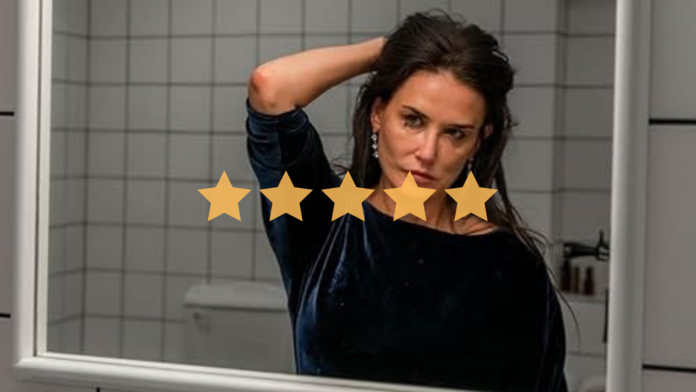Showgirls (1995), Death Becomes Her (1992), All About Eve (1950), Snow White. Stories about successful women forced out of the limelight by the latest shiny new thing is a tale as old as time. But what happens when we take that story and add in some delicious dichotomy of the self and a boatload of blood and viscera? Carolie Fargeat explores just that in her new body horror feature The Substance.
★★★★★
This review contains spoilers
Starring Demi Moore as an ageing starlet who turns 50 and immediately finds herself past her use-by date, The Substance is an incredibly rich feast for any fan of fairy tales, body horror, scathing beauty industry takedowns, and just plain weird stuff. If you’re a fan of beautiful women being absolutely feral and disgusting, this is the film for you.
Forced out of her TV show by the network head (called Harvey and played with peak sleaze by a fully committed Denise Quad), Moore’s Elisabeth Sparkle calls a mysterious number and gets her hands on “The Substance”. This garish neon one-time fixer liquid promises to create a better younger version of yourself to share your life with; one week for her, one week for you, perfectly balanced.
Enter Margaret Qualley as Sparkle’s double, Sue, who soon becomes “the new Elisabeth Sparkle” and has the world at her fingertips. Of course, it all goes wrong from there, as the two entities refuse to honour their balance and quickly forget that they’re both the same person. A fierce rivalry soon emerges between the two versions of Elizabeth as her older self wanes and her younger self waxes.
Fans of Fargeat’s high-octane first feature Revenge (2017) will find themselves satisfied by this revisit to her world of crisp aesthetics and poetic imagery juxtaposed by unrestrained violence and gore. What Fargeat does best is the way she serves up simplistic but heavy-handed imagery in a way that is wildly satisfying in its storytelling precision.

The best example of this talent comes in the opening sequence in which we are offered the rise and fall of Elisabeth’s career through a modest shot of her Hollywood star. Using the image as a heavy-handed stand-in for Elisabeth’s stardom we watch as the seasons of her career pass and the star goes from revered and well cared for, to ignored and finally smeared with ketchup. The sequence is a masterclass in storytelling, giving us all the information we need to understand Elisabeth’s career in one succinct image.
There’s also such a plethora of references and influences at play in The Substance that any hardened fan of the Gothic will find much to enjoy, even with the technicolour facelift and synth-heavy soundtrack. Though the Gothic tradition is typically associated with dark castles and supernatural beings, Fargeat plays with the motifs at the heart of the genre while updating the aesthetics to a more safe-seeming world. Instead of a castle, the haunting takes place through Elisabeth’s flashy apartment with plush carpets and endless natural lighting. Instead of a ghost or supernatural being, we’re treated to a woman haunted simply by herself; her own past and present. When an audience is presented with Elisabeth’s final form they yell monster and the ensuing hysteria evokes James Whale’s Frankenstein (1931) but this monster is draped in aqua tulle and forces a pageant smile.
Fargeat toys with other Gothic classics such as Strange Case of Dr Jekyll and Mr Hyde (1886) with the two versions of one person fighting for dominance, and The Picture of Dorian Grey (1890), with the old Elisabeth, left hidden away to age and decay as Sue thrives. There’s also a delightful playfulness with photographs and billboards as the painting’s stand-in which is present right up until the film’s gooey crescendo where the newly merged Elisabeth/Sue hybrid attaches Elisabeth’s face to hers as a disguise.

Even beyond the playful interactions with genre, there’s a rich tapestry of themes woven throughout the film. Primarily targeting Hollywood with its commentaries on substance abuse (complete with fried eggs), eating disorders, and plastic surgery, all the way through to the obvious criticisms of the beauty industry at large. Fargeat holds no punches and neither Moore nor Qualley shy away from the subject matter, fully committing themselves to the piece.
At the end of the day, however, if all you’re looking for is straightforward blood, guts, and goo, consider yourself fed. The film starts small with close and personal surgical procedures but by the end, it blossoms into a full explosion of gore that will satisfy any body horror gourmand. Fans of Brian Yuzna’s 1989 body horror film Society especially will enjoy it.
When stuff hits the fan, this is absolutely the kind of film you want to watch with an audience. Shout out to the woman in front of me absolutely fighting for her life from the get-go, I hope you had a fantastic time.
Words by Camille Murray
Support The Indiependent
We’re trying to raise £200 a month to help cover our operational costs. This includes our ‘Writer of the Month’ awards, where we recognise the amazing work produced by our contributor team. If you’ve enjoyed reading our site, we’d really appreciate it if you could donate to The Indiependent. Whether you can give £1 or £10, you’d be making a huge difference to our small team.
